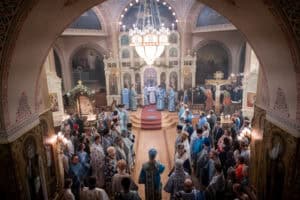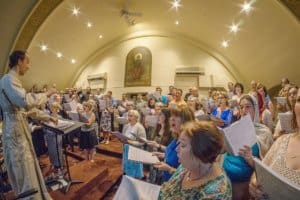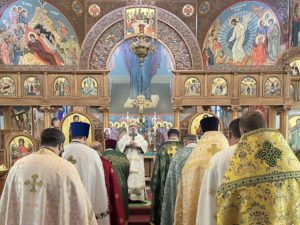PART X
Personal Ecclesial Formation
Our experiences – including our ecclesial lives – do not occur in an ahistorical or non-contextualized vacuum. On the contrary, we are shaped by our personal histories, and then by how we live and act within them. By way of introduction, then, let me briefly describe just where “I am coming from” in offering these modest reflections on the Fiftieth Anniversary of the autocephaly of the Orthodox Church in America, granted via the Tomos of Autocephaly issued on April 10, 1970.
I do not quite go back to that very beginning. I entered the OCA a few years after that crucial year of 1970. Be that as it may, I have been around for some time now, thus making me something of a veteran of living within the canonical boundaries of the OCA for most of my adult ecclesial life; the last thirty-eight years of my ecclesial life, I have served as a parish priest in the OCA. I was baptized and then raised and nurtured in the parish of St. Clement of Ochrid (subsequently renamed St. Paul the Apostle) Macedono-Bulgarian Orthodox Church in Detroit, Michigan. This parish was in the jurisdiction of the Bulgarian Orthodox Archdiocese under the omophorion of the late Archbishop Kirill (Yonchev).
Typical of its time – or of the North American Orthodox experience – this parish experienced a split in the early 1960’s. One group remained under the jurisdiction of the Mother Church in Bulgaria. The other – my parish of St. Paul’s – departed from the alleged communist-controlled Bulgarian Orthodox Church. This split resulted in a canonically-unattached group of parishes which were eventually received by the Russian Orthodox Church Outside of Russia (or ROCOR). It was at the ROCOR monastery of the Holy Trinity in Jordanville, New York, that Bishop Kirill was consecrated. As I recall, the relationship between our Bulgarian parishes and ROCOR was nominal. As long as we remained on the Old Calendar, our relationship with ROCOR’s Synod of Bishops remained intact. Yet, that seemingly stable relationship eventually deteriorated and our parish was received within the canonical embrace of the OCA in 1976. Drearily, this move into the OCA caused further commotion within our small Bulgarian Diocese.
The point here is simply that I did not grow up in a typically Metropolia-style parish. I entered the OCA from a different tradition both historically and liturgically. Although my parish of St. Clement/St. Paul represented an ethnic Orthodoxy, I have the fondest memories of, and am deeply grateful for, my life within that community; and, I hold in great respect my departed parish priest, Fr. George Nicholoff, and the faithful parishioners I grew up with.
Within just a couple of years after my home parish was received into the OCA, my own spiritual awakening – meaning my conscious effort to learn more about the Orthodox Church and Faith that I was raised in – occurred when Orthodoxy was being re-examined and presented in a dynamic and visionary manner by the late Fr. Alexander Schmemann. This was all so stunningly fresh, that it eventually led directly to my enrollment at St. Vladimir’s seminary, once Presvytera Deborah and I were married in 1978. Looking back, studying under Frs. Schmemann, Meyendorff, Hopko and Lazor, together with Professors Verkhovskoy and Kesich, seems like a golden age both in terms of the history of St. Vladimir’s seminary and also in the wider scope of the OCA’s relatively short fifty-year history. Upon my graduation, I was ordained to the priesthood in 1981. I am ever grateful for the Christ-centered vision of all of my former teachers in the Faith, especially as they have passed on to their reward.
This, then, is where I am “coming from” as I now turn to a more direct “sober and critical reflection” on the autocephaly of the OCA.
Autocephaly as a Good Thing
I begin with the first question posed by His Eminence, Archbishop Paul, for our reflection: Why was the autocephaly a good thing then? Why is it a good thing now? To lament the canonically aberrant multiplicity of jurisdictions within North America today is simply of sign of the most rudimentary awareness of canonical order and sound ecclesiology. Who isn’t tired of asking a new convert to Orthodoxy: “Wonderful! And what jurisdiction have you entered into, may I ask?”
No matter how entrenched we are in our jurisdictions, we cannot succumb to a passive or grudging acceptance of jurisdictional/ethnic Orthodoxy. On this level, our autocephaly is a living proof of another way that manifests the Church’s true nature and mission. This will include, within the OCA, the steady proliferation of parishes committed to the usage of English as the primary, if not exclusive, liturgical language of worship. So, the autocephaly of the OCA remains a good thing to the present day. We may prove to be a thorn in the side of the entrenched ethnic Orthodoxy just mentioned; but might not this be a holy provocation that we hope will bear fruit in a future known only to God?
As I already mentioned, I was not in the OCA to participate in the ecstatic and grateful acceptance of the Tomos of Autocephaly back in 1970. The Tomos then must have been accepted as a direct gift from God. I have spoken to some who did participate in that moment; their witness still remains as a faint echo through these last fifty years of what was meant to be.
Autocephaly as a Sign of Ecclesial Maturity
Though it may be painful to bring to mind an era from our not too-distant past that we would rather assign to oblivion, I do so to point out how it demonstrates our autocephaly to be a very good thing indeed, even providential, if we may dare say so. In an article prepared for the commemoration of the forty-fifth anniversary of our autocephaly in 2015, I wrote the following:
“The OCA was facing a real crisis (from the Gk. krisis meaning “judgment”) with the discovery of ecclesial corruption in 2005. Thus, our ecclesial maturity was being put to the test. Were we capable of overcoming the debilitating effects of a financial scandal that was traced to the highest level of leadership? Or did we need outside intervention? (There was even talk of electing as Metropolitan a distinguished bishop from Russia at the Pittsburgh Council of 2008 in order to assist us in the process of getting our house in order). Would we collapse or would we recover? Basically, were we in a state of ecclesial maturity or ecclesial immaturity?
‘By the grace of God, we rose to the occasion. In fact, it is quite remarkable that the OCA has recovered its ecclesial balance so well and in such a short period of time. As an autocephalous Church we solved our own internal breakdown with no intervention from an older mother Church. This is a very convincing sign of our ecclesial maturity.
‘The other autocephalous Orthodox churches were aware of our “time of troubles.” Are they equally aware of our “time of renewal?” I will even wonder out loud if these other churches could have recovered as quickly and convincingly as we did. Would they, too, have pursued with such determination the road toward accountability with an identical and much-needed spirit of critical self-reflection? Perhaps we set a model that should be emulated!
Auotocephaly and Lack of Numerical Growth
Yet, there are other issues besides the essential one of demonstrating our ecclesial maturity under trying circumstances. It is often unpleasant to face the facts in any given situation, but those very facts reveal that the OCA has not grown in overall membership during these last fifty years. Older parishes have died while new missions/parishes have flourished. Demographic, social, cultural and economic forces are all at work in these patterns. That is all part of the cyclical nature of institutional Church life.
Yet, the lack of overall growth has to be accepted as deeply problematic. For, the simple fact is that fifty years is more than enough time to reveal an emerging pattern of either growth or inertia. Like many others, I, too, have embraced over the years the convenient clichés that “We are not counting numbers;” or “We appreciate quality over quantity.” I fully understand that approach. In many ways I still embrace it to this day.
Nevertheless, it seems to me that we need to come to terms with our lack of growth over fifty years. This lack of growth also undermines the OCA’s claim to autocephaly in the eyes of the older autocephalous Orthodox Churches – and especially in the eyes of the multiple jurisdictions here in America. A growing and expanding autocephalous Church would have posed a challenge to the other jurisdictions as to the viability of North American Orthodoxy in a truly indigenous setting. I could be mistaken, but I think that our lack of growth is a significant factor over the years in allowing the other jurisdictions in America to ignore the very issue of autocephaly and to perpetuate the status quo.
To what factors can we attribute this lack of growth? Is the Byzantine ethos of Orthodoxy just too exotic or challenging for North American sensibilities? In an age of Christian relativism and therapeutic Christianity, is the Orthodox Faith too demanding in expecting both doctrinal fidelity to the “faith once and for all delivered to the saints” (Jude 3), and a lifestyle manifesting traditional moral/ethical precepts grounded in the Scriptures? Are our missionary methods not equal to the enormous task set before us? Are our parishes lacking the leadership and witness to the radical nature of the Gospel? Or, are we paying the price in one more area for our jurisdictional confusion that potential converts intuit as a lack of unity and purpose? Perhaps it is a little bit of all of the above. In other words, a formidable task stretches out before us!
Autocephaly is the Right Path
There are really no cogent or convincing arguments against autocephaly on the level of Orthodox ecclesiology or canonical order. Yet, other questions arise; questions perhaps of ecclesial diplomacy. Did the original architects of the OCA’s autocephaly act too hastily? Should they have been more patient and have waited for a more suitable time? Was the OCA insensitive to the prevailing atmosphere of jurisdictional/ethnic Orthodoxy in North America? On the other hand, did the OCA manifest some real visionary initiative within a Church often weighed down by a dubious understanding of Tradition that hardly allows for any challenging change? Did we, essentially, seize the moment in 1970? And if not in 1970 – then when should this have happened? These are big questions. Though I am reluctant to try and answer them on my own, I do believe that the initiative leading to autocephaly in 1970 was the right move.
However, those who recall that prophetic essay of Fr. Alexander Schmemann – “A Meaningful Storm” – written in 1971, will further recall with what boldness and insight he anticipated the objections of those who are content with a frozen Orthodoxy incapable of living up to its own ecclesial and canonical norms. Concluding this article which in itself provoked a storm of intense reaction, Fr. Alexander wrote of the autocephaly as “an almost forced return to the “essential” Orthodox ecclesiology, to its very roots, to those fundamental norms and presuppositions to which the Church always returns when she finds herself in a new situation in “this world” whose “fashion is passing.”
In my mind Fr. Alexander Schmemann, together with Fr. John Meyendorff, had the capacity to rise above the cacophony of angry and fearful voices that, alas, continue to this day when the autocephaly of the OCA becomes a topic of discussion. These two luminaries provided a vision that was scriptural, patristic and canonical. In other words, they had a feel for the “essential” – always a favorite word with Fr. Schmemann. It was their conviction that the autocephaly of 1970 was the right path.
Fifty years later and suffering from a good deal of frustration and fatigue over the issue of North American autocephaly, I would like to join them in that conviction, trusting in the words of Fr. John Meyendorff, written back in 1966: “Let us not deceive ourselves: the unity of Orthodoxy in this country is indeed the will of God.”





